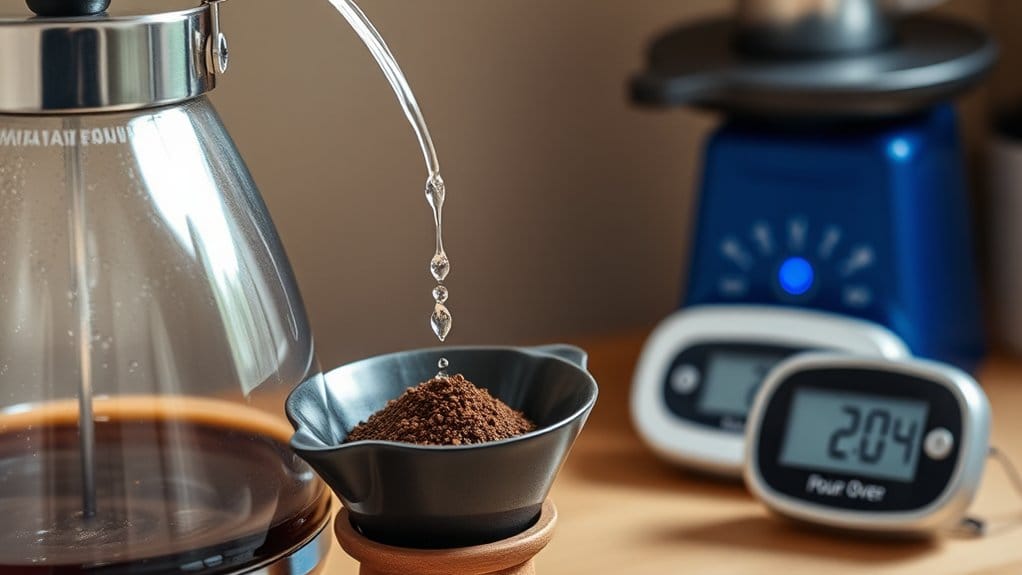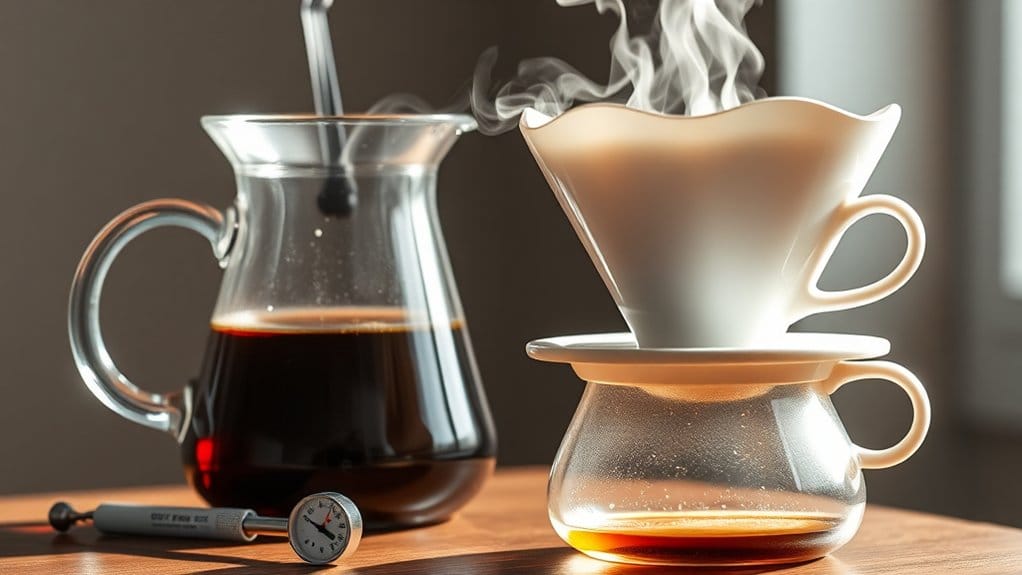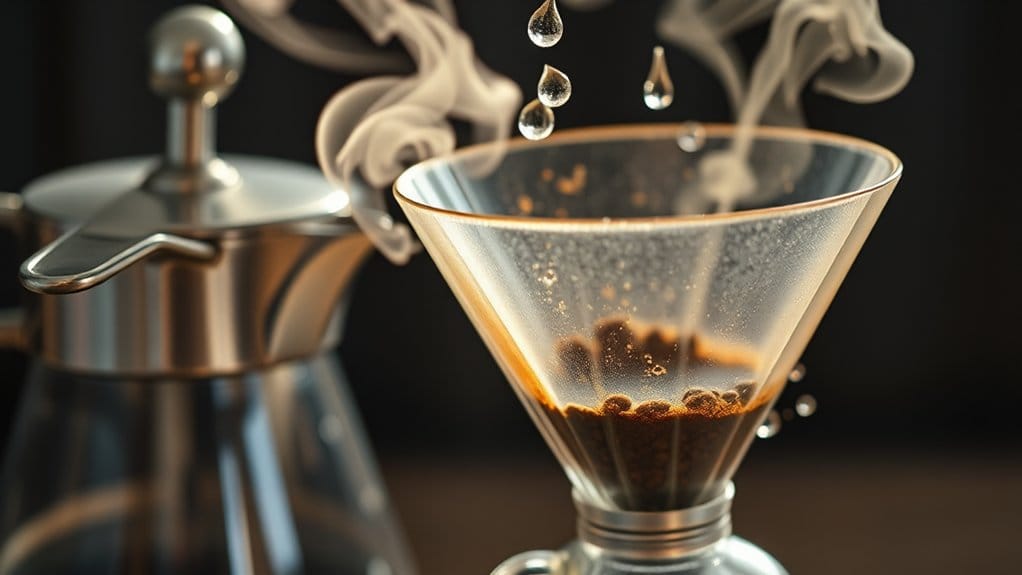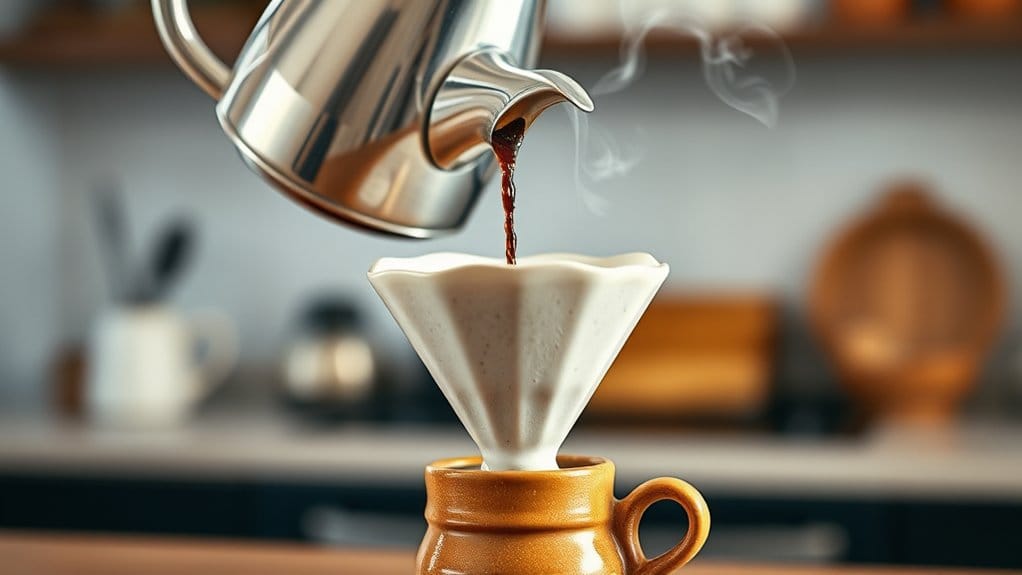Physical Address
304 North Cardinal St.
Dorchester Center, MA 02124
Physical Address
304 North Cardinal St.
Dorchester Center, MA 02124

The ideal water temperature for pour-over brewing is between 195°F and 205°F. This range brings out rich flavors and delightful aromas in your coffee. If your water’s too hot, you risk bitterness; too cool, and you’re left with a weak brew. For light roasts, try higher temps, whereas dark roasts benefit from cooler ones. Want to enhance your morning ritual? Let’s investigate some simple techniques for temperature control and achieve that perfect cup together!

When you brew a pour-over, the water temperature plays a crucial role in how your coffee turns out.
Imagine pouring water that’s either too hot or too cold—what a disaster! At temperatures between 195–205°F (90–96°C), you unlock the full flavor potential of your beans. Go too hot, and you’ll get bitter, nasty sips. Too cool, and your coffee tastes weak and sour, like a bad day. Maintaining the right temperature means that delightful aroma and sweetness shine through in each cup. Higher temperatures can lead to over-extraction, so it’s essential to monitor your brewing closely. Incorrect water temperature can result in bitter, sour, flat, or plain coffee, so always aim for that optimal range to enhance your brewing experience. Additionally, employing precision brewing techniques will allow you to harness the perfect water temperature for the best extraction.
Plus, you can impress your friends with your coffee-making skills! So, don’t let temperature be the villain of your brewing story. Control it, enjoy it, and watch your pour-over magic unfold!
Understanding the ideal temperature for your pour-over coffee isn’t just about picking a number—it’s about enhancing your experience.
For light roasts, crank up the heat! You’ll want water between 203–212°F (95–100°C) to unlock their lively, bright flavors. This ideal temperature range is crucial to prevent sour taste and maximize flavor extraction. Brewing with optimal temperatures helps achieve the best flavor profile for your beans.
Medium roasts? Think a cozy range of 194–203°F (90–95°C) for balanced sweetness without bitterness.
Now, if you’re brewing dark roasts, don’t go too hot—stick to 185–195°F (85–90°C) to savor their rich, smooth notes without a burnt taste.
Feel free to play around within these ranges! Maybe even try adjusting for your unique beans.

Temperature plays a crucial role in how your coffee’s flavors come alive, so figuring it out can feel like a game of science and art. When you brew with water between 195°F and 205°F, you unlock the sweet, fruity notes and avoid bitterness.
If it’s too hot, your cup might taste harsh. On the other hand, cooler water can leave your coffee tasting weak or sour, which is just sad, right? You want that cozy balance!
Remember, different compounds dissolve differently. Sucrose, which brings sweetness, peaks around 201°F. Brewing ranges typically observed between 91-94°C may also influence flavor extraction, so keep an eye on your temperature to enjoy a delightful brew.
With just a little attention, you can create a flavorful masterpiece, turning every cup into a moment of joy. Happy brewing!
Choosing the right equipment can make a world of difference in your pour-over brewing experience.
A gooseneck kettle, with its precision pouring, is a game-changer. You’ll love being able to control the water flow for even extraction. Electric variable temperature kettles, although pricier, allow you to set the exact temperature—no more guesswork!
If you go for a stovetop kettle, just remember to wait for it to cool before pouring.
Digital coffee scales likewise help; they measure coffee and water accurately, ensuring your ratios are spot on.
Finally, pay attention to materials. A ceramic or metal dripper keeps the heat better than plastic, helping you brew a perfect cup every time.
Don’t skimp on these necessities!

Great equipment sets the stage, but the magic happens when you master your brewing techniques.
Start with your water temperature. For the best results, keep it between 195°F and 205°F. Use the higher end, like 200°F, for that initial bloom. This helps to release CO2 and kickstart extraction. If you’re brewing a darker roast, dial it down a tad to avoid any burnt taste. A little adjustment can bring out the coffee’s hidden flavors.
Keep the pours slow and steady, creating a spiral motion—think of it as a choreography! Don’t forget to pre-wet your filter; it retains heat and improves your brew. Remember, the golden ratio for coffee to water is essential for achieving optimal flavor.
Why settle for average when you can have a cup that sings?
One of the secrets to unlocking incredible flavors in your pour-over is crafting customized temperature profiles. Think of it like tuning an instrument. Starting at around 195°F showcases bright, fruity notes without that annoying bitterness.
As you gradually increase to 205°F, you’ll draw out those rich, deeper flavors and oils. Using a precision kettle, you can select exact temperatures, perfect for achieving those complex flavors.
Light roasts thrive in lower temps, whereas dark roasts demand the heat. Try employing pauses in your pouring or even adjusting the temperature mid-brew to really finesse those flavors. Additionally, experimenting with grind size can also enhance the flavor extraction process.
Who knew coffee could be this much fun? Just remember, every cup’s a chance to investigate and delight in new tastes!
Altitude decreases atmospheric pressure, lowering water’s boiling point. When you brew at high elevations, you’ll notice water temperature isn’t as hot, which can lead to under-extraction and less flavorful coffee if you’re not careful.
Yes, you can use a microwave to heat your water, but be cautious. Heat in short bursts, stir between intervals, and always use microwave-safe containers to avoid superheating and guarantee safety during brewing.
To measure water temperature accurately, you can use a digital thermometer for precise readings. On the other hand, boil water and let it sit for about 30 seconds to estimate a suitable brewing temperature without needing a thermometer.
Yes, water quality greatly impacts brewing temperature. It influences extraction efficiency, affecting flavors. With the right mineral content, your chosen brewing temperature will yield balanced, flavorful coffee, whereas poor quality can lead to undesirable results.
You should clean your brewing equipment daily to prevent residue buildup, ensuring consistent temperature control. Weekly scrubs and monthly descaling further improve performance, extending your equipment’s lifespan and maintaining the quality of each cup you brew.